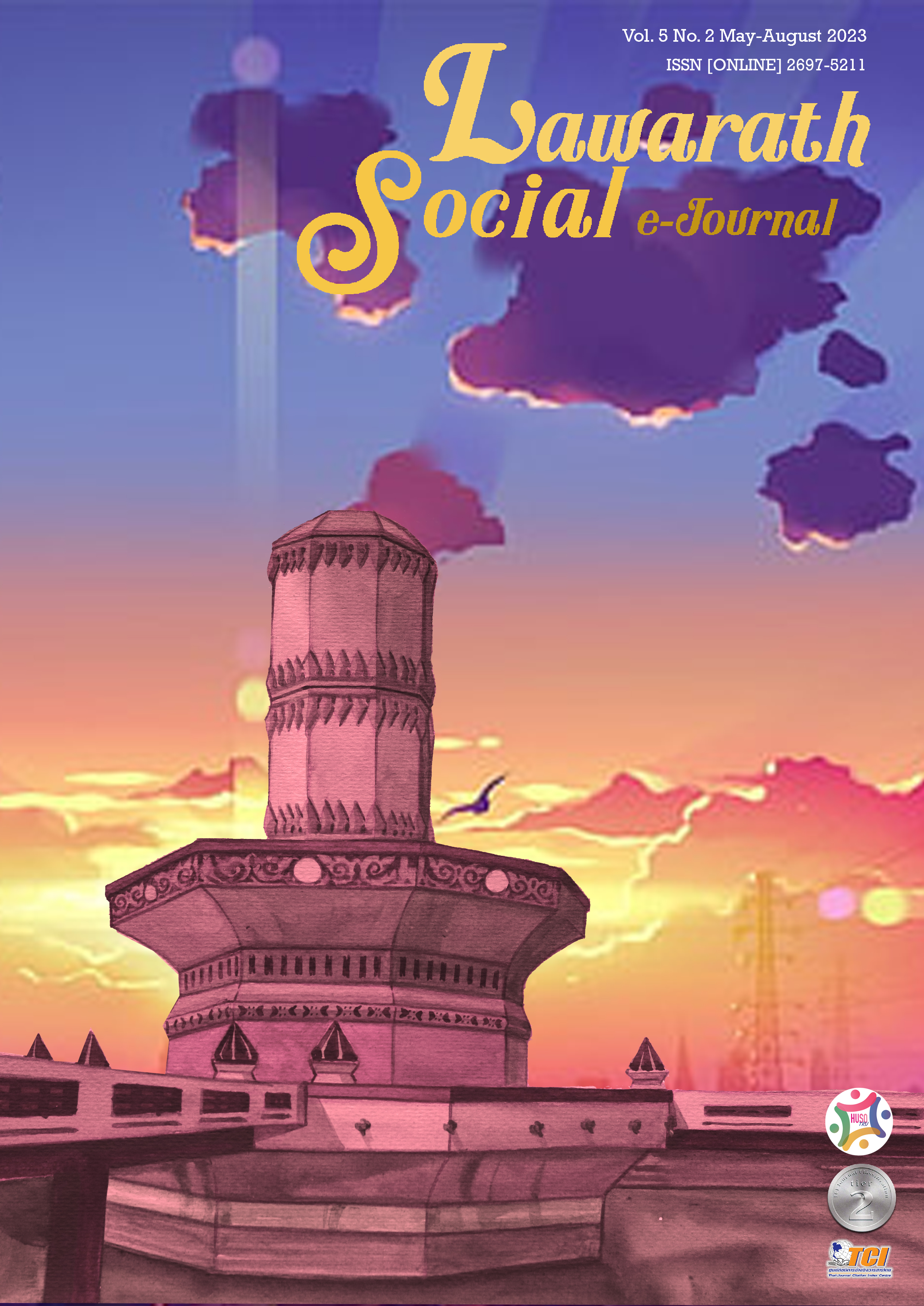An Imagination of Condominiums in Advertising Media
Keywords:
Advertisements, Condominiums , MetaphorsAbstract
This research aims to analyze and explain the imagination of condominiums in advertisements using the theory of metaphors, which is the use of comparative language forms to create an image and expand the meaning of the original words which aims to create analogies in languages. The data were gathered from the different estate ads of the top-three estate developers who had the highest selling records by March 4, 2022. The ads were collected via online platforms which were the official websites and Instagrams of the estate companies from January 2021 to April 2022. The sample companies included AP (Thailand), Sansiri, and Noble. The results showed that there were eight types of metaphors used in condominium advertisements. They included: condominium is one’s personal kingdom, buying a condominium is a wealth, a condominium is a greenspace closed to nature, a condominium is a resort, a condominium is a ladder of life, a condominium is a happiness, a condominium is the combination of man-made places and a condominium is a power. The results also reflected how the comparative words used in advertisements influenced the consumers’ attitudes toward condominiums. It could be seen that the images of the condominiums created by the advertisement were all positive. The most common image of condominiums was the one that showed a meaningful relationship between the residents and green space and nature because this kind of place tends to emphasize a relaxing and healthy environment. Therefore, people who live here could reduce their stress from work and living. On the other hand, the images related to power and the ladder of life were the least commonly found. The reason might be that a ladder is a man-made object which is not perceived as much important as nature.
Downloads
References
ณพงศ์ ปริพนธ์พจนพิสุทธิ์. (2564). รุ่นใหม่ปล่อยเช่าอสังหาฯ. สืบค้น กันยายน 26, 2565, จาก https://www.reic.or.th/News/RealEstate/454672.
ธนพล เอกพจน์, และวิรัช วงศ์ภินันท์วัฒนา. (2560, พฤษภาคม-สิงหาคม). ความทุกข์ คือ โรค: อุปลักษณ์มโนทัศน์ที่สะท้อนผ่านรูปคำอุปลักษณ์ในภาษาไทย. วารสารนานาชาติ มหาวิทยาลัยขอนแก่น, 7(2), 39-58.
นันทนา วงษ์ไทย. (2561, กรกฎาคม-ธันวาคม). มโนทัศน์ "ความเจ็บป่วย" ที่ใช้เป็นอุปลักษณ์ในภาษาไทย. วารสารภาษาและวัฒนธรรม, 37(2), 105-127.
พระมหาอรรถพงษ์ อตถญาโณ. (2561, กรกฎาคม-ธันวาคม). ความแตกต่างของอุปลักษณ์ตามแนวคิดโวหารภาพพจน์ ภาษาศาสตร์ปริชาน และอรรถศาสตร์ปริชาน. วารสารศึกษาศาสตร์ มมร คณะศึกษาศาสตร์ มหาวิทยาลัยมหามกุฏราชวิทยาลัย, 6(2),
-332.
พรรณรัตน์ กานต์ไกรศรี, และอานนท์ ไชยสุริยา. (2556, พฤษภาคม-สิงหาคม). การวิเคราะห์รูปแบบภาษา ภาพพจน์ และการใช้คำของโฆษณาอสังหาริมทรัพย์ในหนังสือพิมพ์บางกอกโพสต์ในช่วงเดือนมกราคม ปีพุทธศักราช 2552 ถึงเดือนมิถุนายน ปีพุทธศักราช 2553. วารสารวิชาการมนุษยศาสตร์และสังคมศาสตร์, 21(36), 81-103.
ภัทรา พิเชษฐศิลป์. (2564, กรกฎาคม-มิถุนายน). ความคิด ความรัก และอาหาร:การศึกษาอุปลักษณ์เชิงมโนทัศน์ในภาษาจีน. วารสารจีนศึกษา มหาวิทยาลัยเกษตรศาสตร์, 14(1), 1-24.
รัชนีย์ญา กลิ่นน้ำหอม. (2556, มกราคม-มิถุนายน). อุปลักษณ์ความสุขในบล็อกไทย. วารสารสถาบันวัฒนธรรมและศิลปะ, 14(2), 132-138.
วิชัย วิรัตกพันธ์. (2565). อสังหาฯ มั่นใจเซนติเมนต์ลูกค้าฟื้น-ลุยขึ้นคอนโดฯ 9 บมจ. มูลค่า 1.3 แสนล. REIC แนะปรับโปรดักต์ เจาะกลุ่ม Gen-Y,Gen-Z. สืบค้น กันยายน 26, 2565, จาก https://www.reic.or.th/News/RealEstate/455315.
วิทวัส รุ่งเรืองผล, และพิชชา ฉัตรชัยพลรัต. (2564, กรกฎาคม-กันยายน). พฤติกรรมการเลือกซื้อคอนโดมิเนียมของกลุ่มลูกค้า Generation Y. วารสารสังคมวิจัยและพัฒนา, 3(3), 1-26.
วุฒินันท์ แก้วจันทร์เกตุ. (2555, กรกฎาคม-ธันวาคม). กิเลส:การศึกษาอุปลักษณ์เชิงมโนทัศน์ในภาษาไทย. วารสารมนุษยศาสตร์, 19(2), 24-41.
ศุภชัย ต๊ะวิชัย. (2550). อุปลักษณ์เชิงมโนทัศน์แสดงอารมณ์โกรธในภาษาไทย. วิทยานิพนธ์ปริญญามหาบัณฑิต มหาวิทยาลัยศิลปากร.
ศูนย์ข้อมูลอสังหาริมทรัพย์. (2565). กำลังซื้อยังไม่ตก ยอดโอนทั้งปี 1.7 แสนหน่วย คอนโดฯ ยูนิตใหม่ทะลัก. สืบค้น กันยายน 26, 2565, จาก https://www.reic.or.th/News/RealEstate/455675.
ศูนย์ข้อมูลอสังหาริมทรัพย์. (2564). AP มั่นใจปีนี้ยอดโอน4หมื่นล้าน โชว์ยอดขายสะสม 3.58 หมื่นล้าน เน้นบริหารพอร์ต. สืบค้น กันยายน 26, 2565, จาก https://www.reic.or.th/
News/RealEstate/454886.
ศิโรรัตน์ ศิริเพ็ญ. (2560, มกราคม-มิถุนายน). กลวิธีการสื่อความหมายในบทโฆษณาที่อยู่อาศัยทางโทรทัศน์. วารสารวจนะ, 5(1), 39-61.
ศิริพร ปัญญาเมธีกุล. (2558, มกราคม–มิถุนายน). การวิเคราะห์ลักษณะภาษาที่พบในสื่อโฆษณา. วารสารวจนะ, 3(1), 56-66.
สำนักงานนโยบายและแผนทรัพยากรธรรมชาติและสิ่งแวดล้อม. (2564). พื้นที่สีเขียว. สืบค้น มกราคม 27, 2565, จาก https://www.onep.go.th/พื้นที่สีเขียว/.
สำนักงานราชบัณฑิตยสภา. (2565). พจนานุกรมฉบับราชบัณฑิตยสถาน พ.ศ. ๒๕๕๔. สืบค้น กันยายน 26, 2565, จาก https://dictionary.orst.go.th/.
Aristotle. (2005). Rhetoric (Nia Sheng Luo, Translated). Shanghai: Shanghai People's Publishing House.
Nattaporn (นามแฝง). (2554). นักภาษาศาสตร์มีแนวทางในการศึกษาอุปลักษณ์อย่างไรบ้าง. สืบค้น พฤศจิกายน 9, 2565, จาก http://semantiq.blogspot.com/2011/08/blog-post_6198.html.
Ullmann, S. (1962). Semantics: An Introduction to the Science of Meaning. Oxford: Blackwell.
Wu, R. (2022). What is The Home. Retrieved June 15, 2022, from http://www.360
doc.com/content/22/0615/04/22221674_1036069329.shtml.
Downloads
Published
How to Cite
Issue
Section
License

This work is licensed under a Creative Commons Attribution-NonCommercial-NoDerivatives 4.0 International License.



